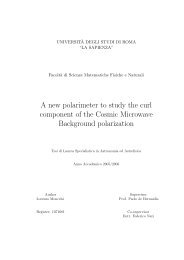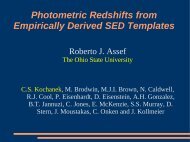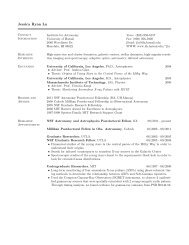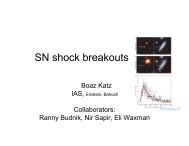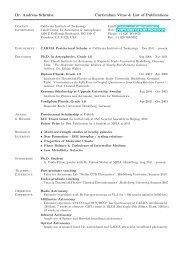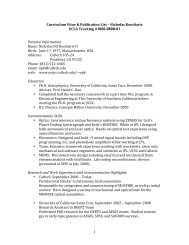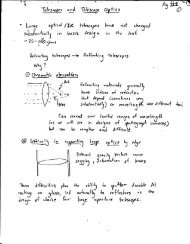Interferometric observations of pre-main sequence disks - Caltech ...
Interferometric observations of pre-main sequence disks - Caltech ...
Interferometric observations of pre-main sequence disks - Caltech ...
You also want an ePaper? Increase the reach of your titles
YUMPU automatically turns print PDFs into web optimized ePapers that Google loves.
30 Introduction to interferometry<br />
tion tens to hundreds <strong>of</strong> time larger than single aperture in the same wavelength do<strong>main</strong>.<br />
They both use arrays <strong>of</strong> telescopes and, as described in the <strong>pre</strong>vious section, have to find<br />
the most suitable telescope configuration to reach their objective. Moreover, both optical<br />
and radio interferometry require to calibrate the measured complex visibilities.<br />
Optical and millimeter interferometry differ, first <strong>of</strong> all, for the angular resolution<br />
that can be achieved, defined by the fringe spacingλ/2B. Fixed the maximum baseline<br />
B, the wavelength dependence implies that an interferometer observing in the near-<br />
infrared may achieve an angular resolution three orders <strong>of</strong> magnitude higher than at<br />
millimeter wavelengths. In practise, the existing millimeter interferometers are charac-<br />
terized by antennas configurations more extended that the optical array and the differ-<br />
ence is generally lower. For examples, while the VLTI has a maximum baseline <strong>of</strong>∼200<br />
m, corresponding to a resolution <strong>of</strong> few milli-arcsec in the near-infrared, the Plateau the<br />
Bure Interferometer can operate with a baseline <strong>of</strong>∼ 700 m and can achieve a resolution<br />
<strong>of</strong>∼0.3 ′′ at 1 mm; for the Very Large Array the resolution is∼0.2 ′′ at 3 cm (B=36000<br />
m). In future, with the Atacama Large Millimeter Array it will be possible to achieve a<br />
resolution <strong>of</strong>∼0.01 ′′ at 1 mm with a baseline <strong>of</strong> 15000 m.<br />
The atmosphere is the source <strong>of</strong> a second important difference. Due to the diver-<br />
sity <strong>of</strong> the temperature between the ground and the upper layers <strong>of</strong> the atmosphere,<br />
convection occurs and creates turbulent eddies, characterized by different refractive in-<br />
dices. When looking to objects through the atmosphere, the rays <strong>of</strong> light are therefore<br />
randomly deviated. The atmospheric turbulence is characterized by the spatial Fried’s<br />
parameter r0, which corresponds to the spatial scale <strong>of</strong> the atmospheric turbulence, and<br />
the coherence time t0, which define the temporal variation <strong>of</strong> the turbulence. At opti-<br />
cal wavelengths, typical values <strong>of</strong> r0 and t0 are in the range 0.1–1 m and 10-100 ms<br />
respectively; moreover, the physical analysis <strong>of</strong> the turbulence shows that both r0 and<br />
t0 depend on the wavelength asλ 6/5 . At optical wavelengths, the dominant effect <strong>of</strong><br />
atmospheric turbulence is the corrugation <strong>of</strong> the wavefront both at the level <strong>of</strong> each in-<br />
dividual aperture, seeing, and at the level <strong>of</strong> the interferometer, atmospheric piston. As<br />
in the case <strong>of</strong> single optical telescopes, interferometers use adaptive optics systems to



